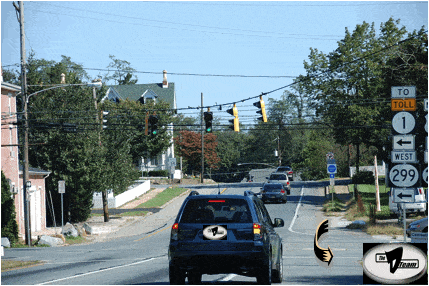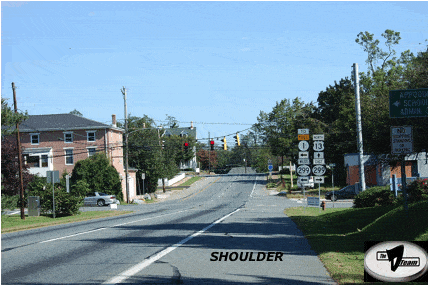One-Way & Two-Way Roads – Passing and Lane Changing
Is North Van Buren Street in Wilmington in the picture above a one-way street or a two-way street?
Easy answer — it is a two-way street. The DOUBLE SOLID YELLOW LINE is separating 2 single lanes of opposite direction traffic. The SOLID YELLOW LINE also indicates no passing.
Is North King Street in Wilmington pictured below a one-way street or a two-way street?

Easy answer — it is a one-way street. The WHITE LINES are separating 3 single lanes of same direction traffic.
Is the I-95 picture below a one-way road or a two-way road?

Easy answer — it is a two-way road. The SOLID YELLOW LINE is separating lanes of opposite direction traffic.
WRONG! WRONG! WRONG!
I-95 pictured above is an example of “2” one-way roads.
IMPORTANT: PASSING requires a return to your original lane. PASSING takes place in a driving environment where the vehicle executing the PASSING maneuver (with a broken yellow line) risks a head-on collision from opposite direction traffic. PASSING also takes place when PASSING left turning traffic on the right using the SHOULDER of the road if necessary. Both PASSING maneuvers cited above require a return to the original lane and only occur on two-way roads.
Take a second look at the I-95 picture above. When moving from one lane to another is there a risk from opposite direction traffic? NO! Is there an opportunity to pass left turning traffic on the right using the shoulder of the road? NO! Then I-95 is not a two-way road.
However, is it legal to CHANGE LANES when traveling in your motor vehicle on I-95? YES! Are you permitted to remain in the lane into which you just moved? YES! Then the I-95 is “2” one-way roads — DUAL ROADWAY/HIGHWAY.
Picture #15-5

ANSWER #1: IT’S NOT! The vehicle in picture #15-5 above seemingly is moving into a right-turn lane and is preparing to turn right. Unfortunately, as we move the picture further back (see picture #15-6 below) it becomes apparent the motorist in the above picture was actually moving onto the SHOULDER of the road to make the right-turn.
There is also no question this motorist believed he/she was performing a legal traffic maneuver — but that is not the case.
Picture #15-6

ANSWER #2: STOP LINES should not be painted on the SHOULDER of the road — it serves only the negative purpose of inconsistency/confusion.
TRAFFIC ALERT: Many Delaware motorists will interpret a SHOULDER with a painted STOP LINE as a legitimate right-turn lane. The only legal maneuver for driving on the SHOULDER of the road according to Delaware Traffic Law is when a motorist is passing left-turning traffic on the right.
Once the passing maneuver has been completed the motorist must return to the through traffic lane (it is also legal to make a right-turn across the SHOULDER to enter a driveway and/or business).
While the “The D Team” was unable to find in Delaware Traffic Law a specific law that prohibits driving on the SHOULDER — the following should be strongly considered before venturing on a driving tour down the road SHOULDER (especially when intending to enter a right-turn lane using the road SHOULDER in the picture below).

The motor vehicles being passed on the right by the utilization of the SHOULDER of the road are not intending to turn left. They are through traffic vehicles. Thus the vehicle traveling on the SHOULDER of the road below is in violation of Delaware Law
TITLE 21
CHAPTER 41. RULES OF THE ROAD
§ 4117. When overtaking on the right is permitted.
(c) When the vehicle overtaken is making or about to make a left turn, the vehicle approaching from the rear may pass on the right using the shoulder if necessary.
Obviously, if a motor vehicle is disabled and cannot maintain the normal flow of traffic, the SHOULDER is where it belongs and the hazard lights should be activated.





